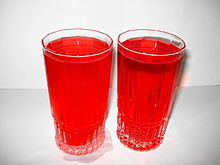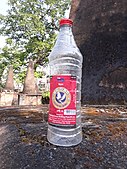





With a climate as varied and extreme as India, the people require a myriad of options to keep their thirst appropriately quenched according to the weather conditions, varying from steaming hot drinks during winters to frosty cold drinks in summers. Different regions in the country serve drinks made with an eclectic assortment of ingredients including local spices, flavors and herbs. Available on the streets, as well as on the menus of posh hotels, these drinks add to the flavorful cuisine of India.
Consumption statistics by drink type[edit]
This is the consumption of drinks per capita per year in India in 2021 by drink type excluding water and juices.[1]
| Drink type | Per capita consumption (liter) |
|---|---|
| Hot drinks | 70 |
| Dairy drinks | 34 |
| Soft drinks | 20 |
| Bottled water | 6 |
| Alcoholic drink | 4 |
| Total | 134 |
Assorted drinks[edit]
- Aam panna – made from raw mango
- Aamras
- Bael panna
- Banta soda, carbonated lemonade sold in codd-neck bottle
- Buransh – made from rhododendron flowers with jelly like consistency, Uttarakhand
- Doodh Soda
- Ela neeru / karikku – tender coconut water
- Fuljar soda – carbonated drink made using crushed chillies, ginger, mint leaves and spice mix
- Fruit juice
- Gaajar ka doodh – made from grated carrot and sweetened milk
- Ganne ka ras or sugarcane juice
- Gud-nimbu sharbat – made of lemon and jaggery
- Jal-jeera
- Jigarthanda, famous in Madurai
- Kahwah is common drink in cold regions of Jammu and Kashmir[2]
- Kala Khatta
- Kanji
- Kesar kasturi
- Khas Khas drink – made from poppy seeds
- Khus sharbat – made from Vetiver syrup
- Kokum sharbat
- Kulukki sharbat – shaken Lemonade
- Liyo
- Nimbu Paani (Lemonade)
- Nannaari (Sarsaparilla) sharbat – lemon-based drink, Tamil Nadu
- Nariyal Pani (Coconut water)
- Neera
- Ookali – hot drink made by boiling coriander seeds, Western India
- Panakam – Beverage made of jaggery and lemon juice, traditionally served on Rama Navami.
- Paneer soda, carbonated lemonade mixed with rose essence and sold in codd-neck bottle is a variation of Banta soda
- Phalsa sharbat – made from Grewia asiatica
- Pudina sharbat – made from mint
- Ramula – a drink made from sweet potato
- Rasna, a soft drink concentrate
- Rooh Afza, a concentrated drink
- Sakar-loung Pani – made from rock sugar and clove; famous in Gujarat, Rajasthan
- Sattu paani – famous in North India
- Saunf paani, from Gujarat
- Sharbat – drink that has many variants
- Shikanjvi – traditional lemonade, often mildly spicy
- Solkadhi
- Sugandha water
- Tanka Toraaṇi – a rice based drink from Odisha
Dairy drinks[edit]
Flavoured milk[edit]


- Badam milk – almond-flavoured milk
- Kesar milk – saffron-flavoured milk
- Rose milk – Rose sharbat – flavoured milk
- Sugandha milk
Milk-based beverages[edit]
- Ambil or Ambli – prepared by using ragi flour and buttermilk, Maharashtra and Karnataka
- Buttermilk – Lassi or Laasi in North India, chhachh or Chaas or Chaah in North India, mor in Tamil, majjiga in Telugu, majjige in Kannada, and taak in Marathi
- Chai with cream – prepared using dry or fresh variants of tea, often has hints of cardamom (elaichi), cinnamon (dalchini) or a mixture of spices, which constitute the special masala chai, taken especially during the cold to keep the winter-related problems at bay
- Doodh soda – mixture of milk and lemon-lime soda
- Haldi doodh or hot turmeric milk
- Lassi – a popular, traditional, yogurt-based drink from Northern India. It is a blend of yogurt, water, spices and sometimes fruit.
- Traditional lassi (a.k.a., "salted lassi", or simply "lassi") is a savoury drink, sometimes flavoured with ground and roasted cumin.
- Sweet lassi, however, contains sugar or fruits, instead of spices. Banarasi Lassi: Varanasi, one of the prominent cities of Bhojpur region is known for special variation of Lassi, popularly known as Banarasi Lassi'. The Curd for Banarasi Lassi is made with reduced milk which gives it a creamy & thick texture. It is then sweetened, churned and served with generous blob of Rabdi in earthen pots called Kulhads.[3][4]

- Mastaani, Pune
- Sharjah Shake – A sweet, cold beverage made from milk, Horlicks/other malt powders and njalipoovan. Sometimes, ice cream, cocoa powder or nuts may be added.
- Sambaram – Salted buttermilk made from cow's milk spiced with shallot, freen chili pepper, ginger and curry leaves from Kerala
- Thandai
Hot drinks[edit]
Both tea and coffee contain caffeine and tannin. Comparatiely, coffee has more caffeine and less tannin than tea, whereas tea has more tannin and less caffeine than coffee.
Coffee[edit]
- Indian filter coffee – a sweet milky coffee made from dark roasted coffee beans (70–80%) and chicory (20–30%)
- Instant coffee
Tea[edit]
- Assam tea
- Ayurvedic teas, various types of Indian herbal teas
- Temi tea
- Darjeeling tea
- Balma green tea
- Berinag tea
- Black tea
- Green tea
- Seven-colour tea
- Irani chai
- Kangra tea
- Masala chai
- Noon chai
- Nilgiri tea
- Tulsi tea
- Milk tea
Flavoured tea[edit]
- Butter tea
- Elaichi tea or cardamom tea
- Ginger tea
- Lemon tea
- Tejpatta Tea
-
Masala chai served with tea biscuits. India's most popular way to drink tea.
-
A cup of Darjeeling tea
-
Butter tea or gur gur in the Ladakhi language, in a bowl; popular in Himalayan regions of India, particularly in Ladakh, Sikkim, and Arunachal Pradesh
Intoxicating drinks[edit]
Traditional[edit]
-
Cashew apples being squashed in Chorao, Goa, to be used in the preparation of feni
-
Handia is a rice beer commonly made by the indigenous people in Jharkhand, Bihar, Odisha, Madhya Pradesh and Chhattisgarh.
-
Desi daru is India's one of the cheapest factory made alcoholic drinks.
-
A bottle of Bangla liquor in Chinsurah, West Bengal, India
The alphabetised list of native traditional drinks is as follows:
- Akani- palm sap from Tamil Nadu.
- Apo – traditional drink from Arunachal Pradesh made from fermented rice
- Arrack-distilled from a wash of palm Jagger, herbs etc. from Kerala
- Bangla – a distilled country liquor made from starch and sold in West Bengal by government licensed vendors.[5]
- Bhang thandai
- Bhang lassi – prepared from leaves and buds of female cannabis plant
- Bitchi – a drink consumed mostly by Garo tribals
- Chhaang or Tongba – drink from Sikkim made from grain millet
- Cholai
- Chuak – a drink from Tripura made from rice, jackfruit and pineapple
- Desi daru
- Feni – an alcoholic beverage made from cashew apple or coconut in Goa
- Gudamaba – brewed from sugar cane in Hyderabad
- Handia – rice beer popularly consumed in Jharkhand
- Hariya
- Kaid Um – drink in Meghalaya, consumed mostly by Khasi and Jaintia tribes
- Kallu – coconut palm sap from Kerala
- Kodo Ko Jaanr – also known as chyang, prepared from finger millet[6]
- Laopani (also called Haanj) – made from fermented rice in Assam, concentrated extract is called Rohi.
- Mandia pej – made from ragi powder and stale water from boiled rice, popular in Odissa
- Manri – made from fermented rice, popular in Mithila
- Rohi – pale yellow coloured extract of Laopani fermented rice drink of Assam, usually offered to the ancestors, priests or elders on special occasions.
- Sekmai – from the state of Manipur; made from sticky rice.
- Sonti
- Sulai
- Sunda Kanji – made from fermenting rice that is buried in earthen or mud pots covered with cloth, sold in Tamil Nadu, India.
- Sura
- Thaati Kallu
- Tharra
- Thuthse
- Toddy/Tadi/Kallu (palm wine)
- Urrak
- Zawlaidi – popular in Mizoram prepared from rice, millet and maize.
- Zutho – from Nagaland
Non-Traditional[edit]
Alphabetised list of non-traditional drinks in India.
- Indian beer
- Indian brandy
- Indian-made foreign liquor
- Indian rum
- Indian vodka
- Indian whisky
- Indian wine
- Lion beer, Asia's first beer brand produced at Kasauli Brewery since 1930, brewery was established by Edward Abraham Dyer,[8] father of Colonel Reginald Edward Harry Dyer "The Butcher of Jallianwala Bagh massacre".[8][9][10][11][12][13]
- Old Monk, well-known rum produced since 1954.
- Solan No. 1, India's first single malt whiskey produced at Kasauli Brewery since 1930 which was started by Edward Abraham Dyer.
See also[edit]
References[edit]
- ^ India consumption of beverages by type Archived 2021-07-10 at the Wayback Machine, Statista., accessed 10 July 2021.
- ^ "Kashmiri Kahwa Tea Recipe: How to Make Kashmiri Kahwa Tea". recipes.timesofindia.com. Archived from the original on 2019-02-13. Retrieved 2019-02-13.
- ^ Gupta, Subhadra Sen (2004). Varanasi: A Pilgrimage to Light. Rupa & Company. ISBN 978-81-291-0165-5. Archived from the original on 2023-04-25. Retrieved 2022-06-21.
- ^ "9 Varanasi (Benaras) Street Foods that You Shouldn't Miss". NDTV Food. Archived from the original on 2022-06-16. Retrieved 2022-06-18.
lassi is available at almost every other street shop from morning till wee hours of the night. It is served in a kulhad topped with Rabri and flavoured with rose essence
- ^ Tathagata Bhattacharya (23 October 2017). "Alcohol and Bengalis: A troubled relationship". National Herald. Archived from the original on 11 July 2018. Retrieved 27 November 2018.
- ^ Tamang, Jyoti Prakash (17 August 2009). "8". Himalayan Fermented Foods: Microbiology, Nutrition, and Ethnic Values. CRC Press. p. 198. ISBN 9781420093254. Archived from the original on 25 April 2023. Retrieved 11 August 2015.
- ^ "Some interesting indigenous drinks among the tribals of Central India" (PDF). Indian Journal of Traditional Knowledge. 6 (1): 141–43. January 2007. Archived (PDF) from the original on 10 September 2014. Retrieved 8 February 2012.
- ^ a b Colvin, Ian Duncan (1929-01-01). The life of General Dyer. Edinburgh; London: W. Blackwood & Sons Ltd. OCLC 1335678.
- ^ Colvin, Ian Duncan (2006-01-01). The Life of General Dyer. Unistar Books. Archived from the original on 2023-04-25. Retrieved 2021-07-10.
- ^ Collett, Nigel (2006-10-15). The Butcher of Amritsar: General Reginald Dyer. A&C Black. ISBN 9781852855758. Archived from the original on 2023-04-25. Retrieved 2021-07-10.
- ^ Saikia, Arunabh (2016-04-23). "How Old Monk went from India's star to another has-been". Mint on Sunday. Archived from the original on 2017-01-25. Retrieved 2017-01-30.
- ^ "Reginald Edward Dyer 1864-1927 - Ancestry". www.ancestry.com. Archived from the original on 2017-02-02. Retrieved 2017-01-30.
- ^ "Reginald Edward Harry Dyer – The Butcher of Amritsar | Lawrence College Ghora Gali". Archived from the original on 2021-07-10. Retrieved 2021-07-10.








